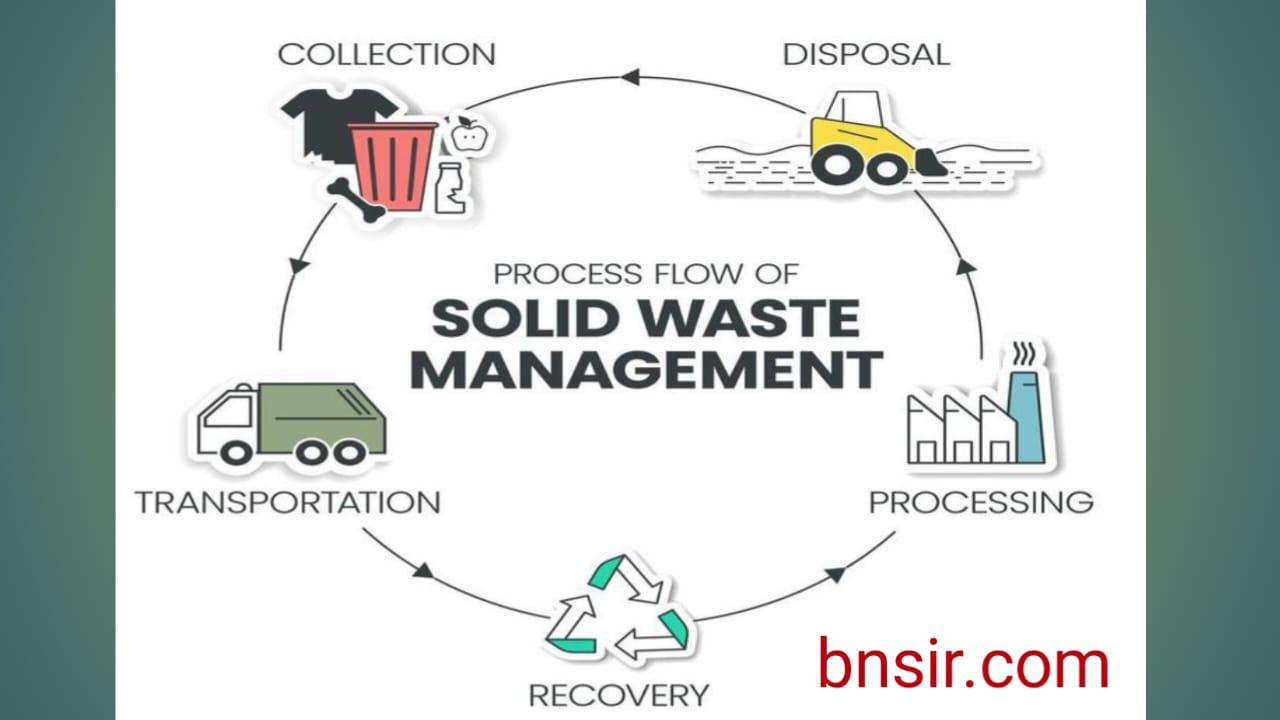Types of Waste Material and Management : Waste material refers to those substances which are thrown away after using them as useless, such as paper, plastic, glass, rubber and cloth etc. are thrown away as useless after human use. Similarly, there are liquid and solid waste material disposed off from industries.

Apart from this, the environment is getting polluted due to the dumping of debris from mines and agricultural waste in open places. Waste materials are found in both solid and liquid forms.
Solid Waste | Understand 2 easy way
Solid waste material are those substances which become redundant and useless after use and which do not have any economic use, such as cans, glassware, plastics, newspapers, residential waste etc. Solid waste has emerged as a problem all over the world. This problem exists in every country as it requires proper disposal and dumping.

The production of solid waste is actually a product of the modern materialistic society. The ‘use and throw culture’ of developed countries is responsible for solid waste pollution. Agricultural waste is a major problem in developed countries, while in developing countries there is no problem of disposal due to the reuse of these materials in many forms.
The following effects of solid waste are as follows:
- Effects on Human Health: Solid waste has adverse effects on human health. The effect of solid waste can be both direct and indirect on humans, such as chemical poison reaching the body with air, lack of weight in children at birth, cancer, congenital malformation, neurological diseases, nervousness and vomiting, Diabetes problem.
- Effects on animals and aquatic life: Mercury gets mixed with water through solid waste, thus resulting in death of fishes due to contaminated water, occurrence of algae bloom, reduction in water and soil quality.
- Impact on environment: Methane gas is generated due to waste. Which is a greenhouse gas
- Littering: Illegal dumping due to contaminated waste.
- Leaching: It is a process in which solid waste It reaches the soil and underground water and contaminates them.
Causes of Solid Waste Problems
- Rapid urbanization,
- Change in lifestyle,
- Inadequate government policies,
- Rapid population growth,
- Public apathy.
Treatment of Solid Waste Material There are many methods of solid waste treatment, the main ones being
Types are-
- Landfill: It is a pit-like area generally located in urban areas in which solid waste is brought and dumped. After it is completely filled, it is filled with soil.
- Incineration (Incineration): Incineration is a disposal method that involves the combustion of waste material. In incineration, solid waste material is burnt at 1000°C. Solid wastes are converted into ash, gas and energy. The energy generated from this is used to generate electricity. It is recognized as a practical method for hazardous waste (such as biological medical waste) disposal, but incineration as a method of waste disposal is controversial due to the emission of gaseous pollutants.
- Marine Dumping: In this the waste material is dumped on the sea coast (mainly on the submerged coast). Mainly garbage, waste material and chemical and nuclear waste are dumped. This affects the aquatic ecosystem and human health.
- Biological reprocessing: In this process, plants, food waste material and paper products can be converted into organic materials through decomposition. In this process, the waste is kept in a container until it decomposes.
- Thermolysis: In this process the waste material is burnt in the absence of oxygen or in a controlled amount of oxygen. Charcoal, tar, acetone and fuel gas etc. are produced by thermal decomposition of organic substances. This type of plants are installed in many cities of India.
- Composting: It is a biological process in which organic wastes are converted into humus by microorganisms like bacteria and fungi in the presence of oxygen. The end product is rich in carbon and nitrogen and is suitable for plant growth.
- Vermiculture: Under this, earthworms are added to the waste material, which make it rich in nutrients by breaking these materials and excreting them.
Revised Rules of Solid Waste Management
● 16 years by Ministry of Environment, Forest and Climate Change in April 2016 After the rules of waste management have been revised and implemented.
● This rule was amended for the purpose of proper management of solid waste increasing in the country.
● Earlier the waste management rule was implemented only in the municipal corporation, but now in the new rule, in addition to the corporation areas, urban clusters, census towns, notified industrial townships, Indian Railways, airports, seaports, places of religious and historical importance, etc. will also apply.
● Under the new rule, it has been arranged that no person shall dump the solid waste generated by him outside his premises on roads, open public places or drains or in water bodies. He will throw it, but he will neither burn it nor bury it in the ground.
● It will be mandatory for the solid waste generator to pay a user fee, which will be provided to the waste collector.
● Under these rules, sanitary napkins and diaper manufacturers Separate companies for proper disposal of waste It has been made mandatory to provide smaller bags.
● Under the new rule, local bodies can charge some fee for better management of waste.
● These rules also provided that if any public If he defecates at the place, he should be fined. •
● To monitor the overall implementation of these rules by the Government A Central Monitoring Committee has also been constituted under the chairmanship of Secretary, Ministry of Environment, Forest and Climate Change for the purpose.
Solid waste management
- Annual report for 2018-19 was presented by the State Pollution Control Board/Pollution Control Committees.
- Based on this report approximately 152076 tonnes of solid Garbage is generated.
- Only 149748 tonnes (98.5 percent of the total) of garbage is collected every day.
- Use of only 55759 tonnes (35 per cent) of waste each day Has been done
- 50161 tonnes (33 per cent) of waste is to be dumped in landfills.
- 46156 tonnes of waste i.e. one third of the waste goes waste.
Liquid Waste
It is that form of waste which is found in liquid state, such as oil spills and sewage etc. It is the main source of water pollution reason. Liquid waste is a major health hazard. It causes diseases like jaundice and diarrhoea.
Oil Spills
Plankton, fishes and sea creatures die due to oil spillage due to accidents of oil tankers in sea areas and pollution due to oil spills in coastal areas. More than 100 million tonnes of oil is transported every year and about 6.01% of oil spills into the sea during transportation. In this way, 200 lakh gallons of oil pollutes the sea water every year. Leaks in international oil pipelines also cause problems of oil spills.
E-waste
E-waste refers to such waste which is generated due to disuse and disuse of electrical and electronic equipment. Many dangerous chemicals and heavy metals like lead, cadmium, beryllium are found in these. These wastes are dangerous for human health along with pollution.
sources of e-waste
Computer, Television, Radio, Mobile, Washing Machine, Microwave Oven, CD Player, Fan, Electric Iron, ECG Machine, Microscope, Incubator, Fax Machine, Xerox Machine, Scanner, Tubelight, All Kinds of Electrical Plant.
E-Waste Management
Through e-waste management, we manage the waste that is generated due to the disuse of electrical and electronic equipment, under which we adopt the same process of land filling which is adopted in solid waste. Combustion process is also an effective way for e-waste management. Apart from this, there are some other techniques of e-waste treatment by which e-waste can be treated.
Environment Degradation
Degradation In general, the meaning of environmental degradation and environmental pollution is the same because both are related to the quality of the environment. But there is some difference on the basis of the area and scale of their influence.
Environmental pollution simply means the decline in the quality of the environment at the local level by human actions, while environmental degradation means the decline in the quality of the environment at the local, regional and global level by human actions and natural processes and folding and faulting, land blocks Rise and fall, earthquakes, floods, droughts, atmospheric storms, outbreak of fire in forest, crop rain and natural lightning discharge, landslides, physical production etc. are the natural factors by which disturbance occurs in the ecosystem at local and regional levels. Environmental degradation begins.
About 80% of the diseases occurring in India are due to non-management of solid, liquid waste, sewage, harmful medical waste and e-waste.
The method of waste management should be different for developed and developing countries, cities and villages, residential and industrial areas because the level of danger of waste also varies from place to place. Apart from this, solid and liquid, normal and radioactive and hospital and e-waste disposal method should also be different in waste management.
Types of Waste Material and Management : With the YouTube Vedio 🎬

